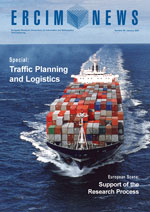by Antonio Lucas
Past and present visions of an effectively managed and integrated road transport system have in general missed a key point: the informed and cooperative road user. This is disappointing, because even in the most sophisticated scenario (eg ADAS), the power of decision and the freedom to use electronic devices will be on the driver's side. Comprehensibility and credibility of devices within the ITS domain are essential for road users and thus for the improvement of the entire transport system. Recent European initiatives both within DG TREN (Easy way) and DG INFSO (e-Safety) have brought new attention to this important issue.
In 1970 more than 90,000 drivers died on European roads, and congestion and accidents stood out as the main issues to tackle. Within the COST framework (European Cooperation in the field of Science and Technology), 'electronic aids' helped to optimize existing transport networks through the considered use of road information. In the 1980s and 1990s, radio broadcasting and variable message signs (VMS) emerged as the first systems to bring real-time information to the road environment.
Since then, a variety of bodies have worked to develop a specific context for telematic implementation. Various projects exist within the European Framework Programs (Drive I and II, Transport etc), and the Directorate-General for Energy and Transport (DG TREN) has strongly promoted Euro-regional projects (ARTS, SERTI, CORVETTE etc) for Intelligent Transport Systems (ITS). In the last thirty years, these research efforts and road safety policies have contributed to the number of people dying annually on European roads being halved to 45,000. In 2001 the European Commission stated in the so-called Lisbon agenda that this death toll was still unacceptably high, and the challenge was then set to achieve a further 50% reduction by 2010. In achieving this, technology will again play a crucial part.
As a complex multinational and multilingual environment, Europe must work hard to keep up with ITS (now also e-Safe) technology as it is applied to road mobility and safety. Sadly, the European road user, the last link in the implementation chain, has somehow been neglected. For instance, while VMS applications are now a mature technology (ie efficient and cost effective), the United Nations' Convention on Road Signs and Signals, which claims to have produced a catalogue of standard signs with which to inform road users worldwide, includes a bare minimum of useful pictograms to indicate variable or dynamic events (eg pictograms for fog or 'ghost drivers' are still missing).
As far back as the 1970s, VMS were recognized as tools that would improve mobility and safety by virtue of traffic-flow re-distribution - thereby aiding traffic planning and logistics. However, after twenty years of VMS implementation, pictograms or graphics able to indicate or recommend rerouting schemes are only just beginning to emerge in Europe (see Figure 1; to date only the congestion pictogram enjoys official acceptance in the UN catalogue).

Turning to more recent tools, the implementation of RDS-TMC (Radio Message System-Traffic Message Channel), which brings real-time traffic information to vehicles, has been affected by commercial and institutional procrastination. While countries such as Germany and Spain make traffic information freely available via public radio, some popular navigators are sold without TMC receptors. These navigators are therefore unable to take public traffic information into account, something many road users are unaware of. It appears that highly speculative 'business case' reasons are responsible for this absurd state of affairs.
Another inconsistency occurs in digital maps and navigators that do not include a subject-profile facility. For example, some tunnels in Spain have vehicle weight restrictions. Tunnel operators sometimes report trucks having to turn back and take an alternative route (specified several kilometres before the tunnel). The reason is simple: many truck drivers rely on navigators built for cars. These navigators thus neglect the obvious needs of a very important group, despite the growing volume of international freight and the consequences of this on planning and logistics.
VMS and RDS-TMC are 'old' technology, which after twenty years should have produced a greater benefit for society. Both DG TREN (promoting initiatives such as the Mare Nostrum project for VMS harmonisation in Europe) and DG INFSO (promoting TMC and user-awareness working groups within the broader eSafety initiative) appear to recognize this.
However, something is clearly missing from our modus operandi when it comes to planning the penetration of technology: either we forget about end users or we take them for granted. We live in an era that burgeons with technological innovations marked by unending acronyms: for example, ESP (Electronic Stability Program), V2V (Vehicle-to-Vehicle communication), V2i (Vehicle to Infrastructure), FCD (Floating Vehicle Data) and ADAS (Advanced Driver Assistance Systems). How will these innovations complement each other? What response is expected from users, and can we predict their behavioural adaptations? And most importantly, why is it still so common for highly sophisticated technologies to be designed, developed and promoted "for the road user but without the road user"?
On top of this, road users are clearly paying the toll of inconvenient events and avoidable road accidents. The introduction into the market of new navigation and road safety technology tends to be much slower and more difficult than for engines and mechanical devices. This is simply a failure of education: the user is unaware of or uninterested by them and as a consequence, many potential success stories have yielded to a massive reliance on hands, wheel, horn and blinkers. In the meantime, congestion and the optimisation of road flows and road infrastructures is still the main issue for our transport systems and will continue to be so for the foreseeable future.
Links:
Mare Nostrum VMS project: http://www.arts-mip.com/vms/default.asp
UN-ECE "Small Group on VMS harmonisation": http://www.unece.org/trans/main/
SOMS/IN-SAFETY project: http://www.insafety-eu.org/
eSafety initiative: http://www.escope.info/
Euro-regional projects: http://www.i2tern.info/
Please contact:
Antonio Lucas
Road Safety and Traffic Institute,
University of Valencia, Spain.
Tel: +34 96 3393880
E-mail: antonio.lucas-alba![]() uv.es
uv.es









